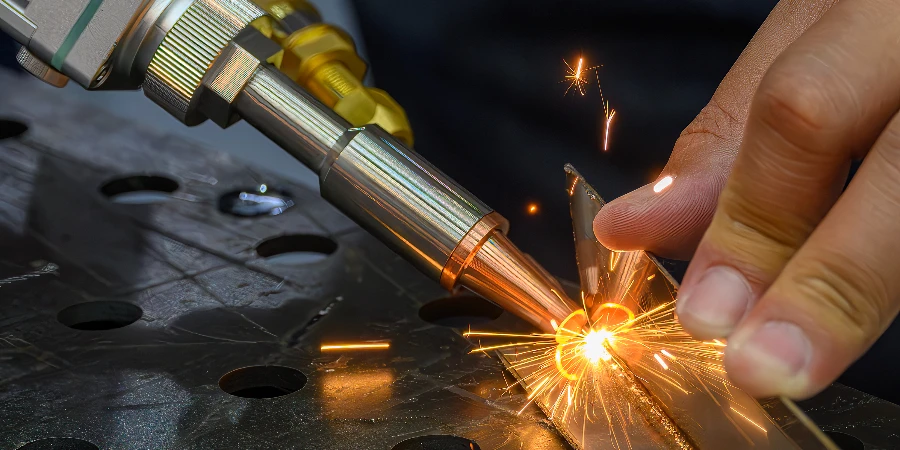Im Jahr 2025 wird der globale Markt für tragbare Laserschweißgeräte sein rasantes Wachstum fortsetzen, angetrieben von Automatisierungs- und Präzisionsanforderungen. Dieser Artikel bietet eine eingehende Analyse der wichtigsten Faktoren für professionelle Käufer, um eine optimale Produktauswahl und Marktwettbewerbsfähigkeit sicherzustellen. Informieren Sie sich über die neuesten technologischen Fortschritte und Compliance-Standards, um fundierte Kaufentscheidungen zu treffen.
Table of Contents:
– Marktübersicht für tragbare Laserschweißgeräte
– Detaillierte Marktanalyse für tragbare Laserschweißgeräte
– Wichtige Faktoren bei der Auswahl eines tragbaren Laserschweißgeräts
– Neueste Technologiefunktionen bei tragbaren Laserschweißgeräten
– Einhaltung gesetzlicher Vorschriften und Zertifizierungen
– Ersteinrichtung und Wartung
– Zusammenfassend
Marktübersicht für tragbare Laserschweißgeräte
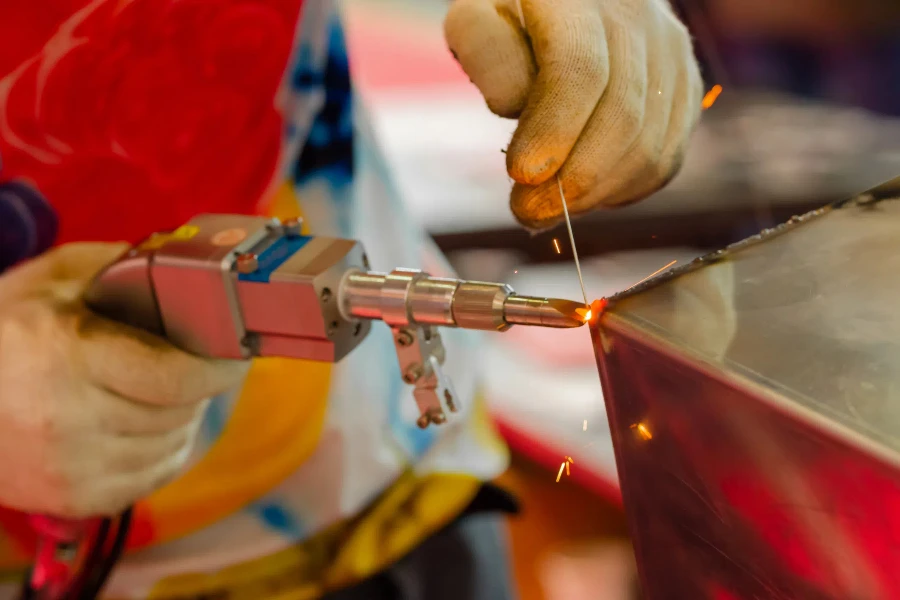
Der globale Markt für tragbare Laserschweißgeräte hat ein beträchtliches Wachstum gezeigt und wird voraussichtlich diesen Aufwärtstrend fortsetzen. Im Jahr 2024 erreichte der Markt für Laserschweißgeräte 7.59 Milliarden USD, mit einer erwarteten durchschnittlichen jährlichen Wachstumsrate (CAGR) von 9.17 %, und soll bis 12.95 2030 Milliarden USD erreichen. Dieses Wachstum wird durch die zunehmende Automatisierung in der Fertigung und die Nachfrage nach Präzisionsschweißlösungen in verschiedenen Branchen wie der Automobil-, Luft- und Raumfahrt- und Elektronikbranche vorangetrieben.
Der asiatisch-pazifische Raum ist Marktführer mit bedeutenden Beiträgen aus Ländern wie China, Japan und Südkorea, die von einer schnellen Industrialisierung und Fertigungsaktivitäten angetrieben werden. Auch Amerika und Europa weisen eine starke Marktpräsenz auf, insbesondere in den Bereichen Automobil und Luftfahrt. Die Nachfrage nach umweltfreundlichen und effizienten Schweißlösungen treibt das Marktwachstum weiter voran, unterstützt durch staatliche Initiativen zur Förderung fortschrittlicher Fertigungstechnologien.
Handgeführte Laserschweißgeräte erfreuen sich aufgrund ihrer Vielseitigkeit, Benutzerfreundlichkeit und Fähigkeit, hochpräzise Schweißnähte auszuführen, zunehmender Beliebtheit. Diese Werkzeuge sind unverzichtbar für Anwendungen, die komplizierte Schweißaufgaben erfordern, wie etwa bei der Herstellung von medizinischen Geräten und elektronischen Komponenten. Die Expansion des Marktes wird auch durch laufende technologische Fortschritte und die Integration von Prinzipien der Industrie 4.0 vorangetrieben, die die Produktivität steigern und die Betriebskosten senken.
Detaillierte Marktanalyse für tragbare Laserschweißgeräte
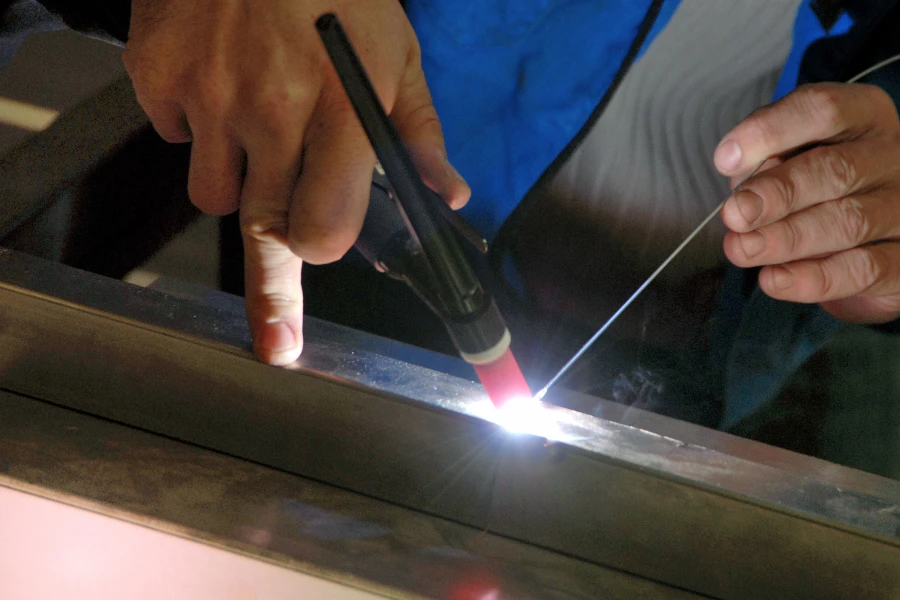
Handgeführte Laserschweißgeräte haben sich als unverzichtbare Werkzeuge in der modernen Fertigung etabliert und bieten beispiellose Präzision und Effizienz. Zu den wichtigsten Leistungsmaßstäben dieser Geräte gehören hohe Leistungsabgabe, einstellbare Strahlqualität und fortschrittliche Steuerungssysteme. Der Markt bietet eine breite Produktpalette für die unterschiedlichsten Anforderungen der Endnutzer, von Kleinbetrieben bis hin zu großen Industrieanwendungen.
Große Akteure wie IPG Photonics, Coherent Corp. und TRUMPF SE + Co. KG dominieren die Branche und nutzen ihr technologisches Know-how und ihre umfangreichen Vertriebsnetze. Steigende Arbeitskosten und der Drang zur Automatisierung haben die Einführung handgeführter Laserschweißgeräte vorangetrieben. Die Nachfrage der Verbraucher nach hochwertigen, langlebigen Produkten hat das Marktwachstum weiter angekurbelt.
Die Vertriebskanäle für tragbare Laserschweißgeräte entwickeln sich weiter. Dabei werden Direktverkäufe und Online-Plattformen immer beliebter, da sie den Kunden einen einfacheren Zugang zu den neuesten Technologien ermöglichen. Zu den jüngsten Innovationen zählen kompaktere und tragbarere Geräte, verbesserte Kühlsysteme und verbesserte Benutzeroberflächen. Diese Fortschritte erfüllen die Kundenanforderungen hinsichtlich einfacher Bedienung und Wartung und machen tragbare Laserschweißgeräte zu unverzichtbaren Werkzeugen in der Präzisionsfertigung.
Die Digitalisierung und die Integration intelligenter Technologien verändern den Markt für tragbare Laserschweißgeräte. Echtzeitüberwachung und Datenanalysefunktionen ermöglichen es Herstellern, Schweißprozesse zu optimieren, Ausfallzeiten zu reduzieren und die Gesamtproduktivität zu steigern. Auch gesellschaftliche Trends, die Nachhaltigkeit und Energieeffizienz betonen, treiben das Marktwachstum an, da Laserschweißen im Vergleich zu herkömmlichen Methoden von Natur aus umweltfreundlicher ist.
Wichtige Faktoren bei der Auswahl eines tragbaren Laserschweißgeräts
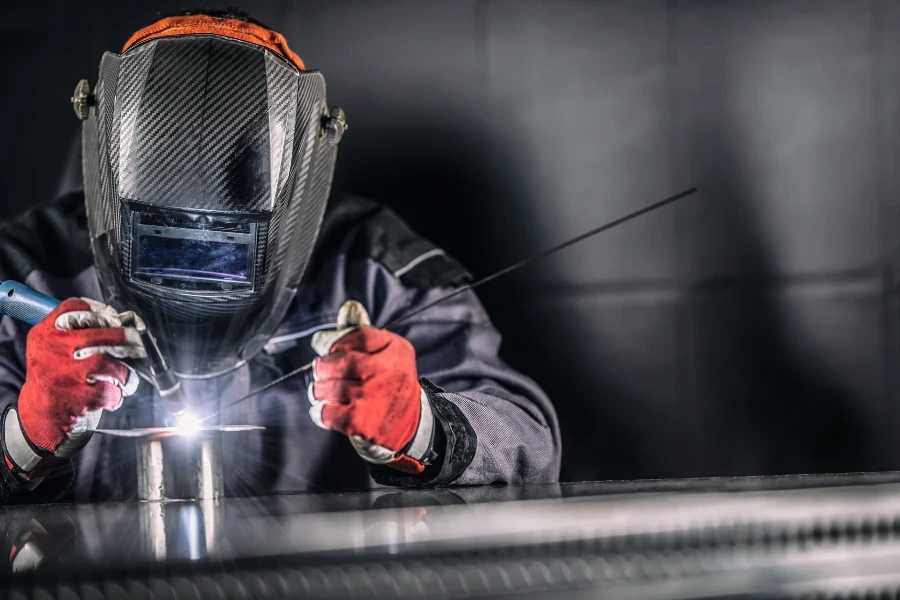
Bei der Auswahl eines tragbaren Laserschweißgeräts müssen mehrere wichtige Faktoren berücksichtigt werden, um optimale Leistung und Effizienz für Ihre spezifische Anwendung sicherzustellen. Zu diesen Faktoren gehören Lasertyp, Leistungsabgabe, Benutzerfreundlichkeit, Sicherheitsstandards und Kompatibilität mit anderen Geräten. Jeder dieser Aspekte spielt eine entscheidende Rolle bei der Bestimmung der Eignung eines tragbaren Laserschweißgeräts für verschiedene Schweißaufgaben.
Laser-Art
Der in einem Handschweißgerät verwendete Lasertyp hat erhebliche Auswirkungen auf dessen Leistung und Anwendung. Zu den gängigen Lasertypen gehören Kohlendioxidlaser (CO2) und Neodym-dotierte Yttrium-Aluminium-Granat-Laser (Nd:YAG). CO2-Laser emittieren Licht mit langen Infrarotwellenlängen, normalerweise etwa 10 µm, wodurch sie sich gut für Schneid- und Markierungsanwendungen eignen. Nd:YAG-Laser hingegen arbeiten mit einer Wellenlänge von 1064 nm und können sowohl im gepulsten als auch im Dauerbetrieb betrieben werden, wodurch sie sich ideal zum Schweißen von Stahl und Superlegierungen eignen.
Die Wahl zwischen diesen Lasertypen hängt von den Materialien ab, die Sie schweißen möchten, und der erforderlichen Präzision. Beispielsweise sind CO2-Laser für nichtmetallische Materialien effektiver, während Nd:YAG-Laser aufgrund ihrer höheren Leistung und Vielseitigkeit für Metallschweißaufgaben vorzuziehen sind.
Leistung
Die Leistungsabgabe eines tragbaren Laserschweißgeräts ist entscheidend für seine Fähigkeit, verschiedene Materialien und Dicken zu verarbeiten. Laserschweißgeräte haben normalerweise eine Leistung von 500 Watt bis zu mehreren Kilowatt. Die erforderliche Leistung hängt von der Materialart und der Dicke der Werkstücke ab. Beispielsweise erfordert das Schweißen dickerer Bleche oder hochfester Legierungen im Allgemeinen eine höhere Leistungsabgabe, um eine tiefe Durchdringung und starke Schweißnähte zu erzielen.
Um effizientes und effektives Schweißen zu gewährleisten, ist es wichtig, ein Schweißgerät mit ausreichender Leistung auszuwählen. Schweißgeräte mit zu geringer Leistung haben möglicherweise Probleme mit dickeren Materialien, was zu schlechter Schweißqualität und möglicher Nacharbeit führt. Umgekehrt kann es bei Schweißgeräten mit zu hoher Leistung zu übermäßiger Wärmezufuhr kommen, was zu Verformungen oder Schäden an empfindlichen Bauteilen führen kann.
Benutzerfreundlich
Die Benutzerfreundlichkeit ist ein weiterer wichtiger Aspekt bei der Auswahl eines tragbaren Laserschweißgeräts. Moderne Schweißgeräte verfügen über verschiedene Funktionen zur Verbesserung der Benutzerfreundlichkeit, wie intuitive Bedienoberflächen, ergonomisches Design und Leichtbauweise. Diese Funktionen verringern die Ermüdung des Bedieners und verbessern die Gesamtproduktivität.
Darüber hinaus bieten einige tragbare Laserschweißgeräte erweiterte Funktionen wie automatische Parameteranpassung und Echtzeitüberwachung, die den Schweißvorgang vereinfachen und konsistente Ergebnisse gewährleisten. Diese benutzerfreundlichen Funktionen sind insbesondere in Produktionsumgebungen mit hohem Volumen von Vorteil, in denen Effizienz und Wiederholbarkeit von größter Bedeutung sind.
Sicherheitsstandards
Sicherheit ist beim Umgang mit Hochleistungslasergeräten ein vorrangiges Anliegen. Handgeführte Laserschweißgeräte müssen strenge Sicherheitsstandards erfüllen, um den Bediener vor potenziellen Gefahren wie Laserstrahlung, Stromschlägen und dem Kontakt mit schädlichen Dämpfen zu schützen.
Suchen Sie nach Schweißgeräten, die internationale Sicherheitsstandards erfüllen, wie z. B. ANSI Z136.1 für den sicheren Einsatz von Lasern und BS EN 60825-1 für die Sicherheit von Laserprodukten. Darüber hinaus bieten Schweißgeräte, die mit Sicherheitsfunktionen wie Schutzgehäusen, Verriegelungen und Not-Aus-Schaltern ausgestattet sind, dem Bediener zusätzlichen Schutz.
Kompatibilität mit anderen Geräten
Kompatibilität mit anderen Geräten und Systemen ist wichtig, insbesondere in integrierten Fertigungsumgebungen. Handgeführte Laserschweißgeräte sollten mit vorhandenen Geräten wie CNC-Maschinen, Roboterarmen und anderen Automatisierungssystemen kompatibel sein. Diese Kompatibilität gewährleistet eine nahtlose Integration in Produktionslinien und verbessert die allgemeine Betriebseffizienz.
Darüber hinaus bieten Schweißgeräte, die verschiedene Kommunikationsprotokolle und Schnittstellen wie USB, Ethernet und drahtlose Konnektivität unterstützen, mehr Flexibilität und lassen sich leichter mit anderen Geräten integrieren. Diese Interoperabilität ist entscheidend für die Schaffung eines vollständig automatisierten und vernetzten Fertigungsökosystems.
Neueste Technologiefunktionen bei tragbaren Laserschweißgeräten
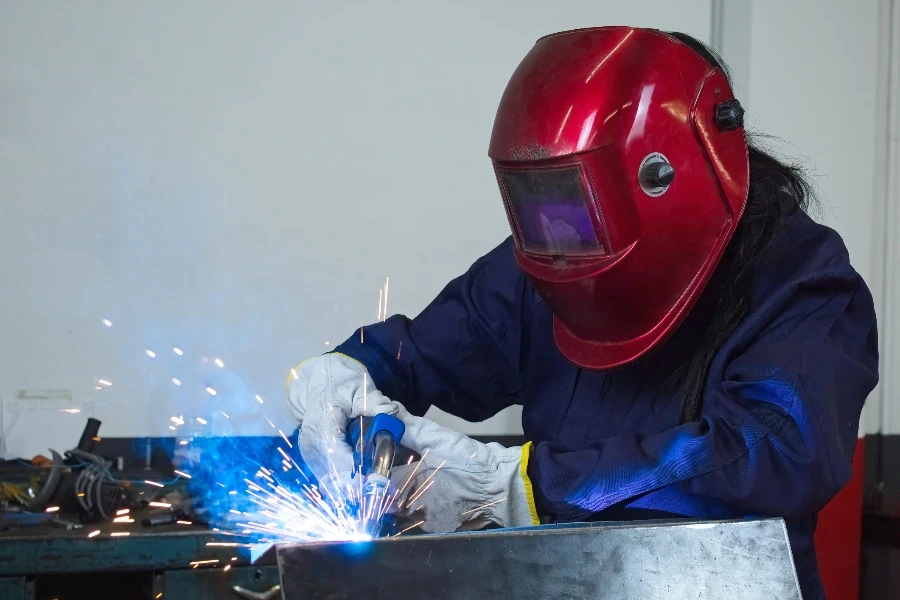
Handgeführte Laserschweißgeräte haben bedeutende technologische Fortschritte erfahren, die ihre Leistung, Präzision und Benutzerfreundlichkeit verbessert haben. Diese Innovationen erfüllen die sich entwickelnden Bedürfnisse verschiedener Branchen, von der Automobilherstellung bis zur Luft- und Raumfahrttechnik.
Echtzeitüberwachung und -steuerung
Einer der neuesten technologischen Fortschritte bei tragbaren Laserschweißgeräten ist die Integration von Echtzeit-Überwachungs- und Steuerungssystemen. Diese Systeme verwenden Sensoren und fortschrittliche Software, um Schweißparameter wie Laserleistung, Geschwindigkeit und Fokus in Echtzeit zu überwachen. Diese kontinuierliche Rückkopplungsschleife ermöglicht es den Bedienern, sofortige Anpassungen vorzunehmen und so optimale Schweißbedingungen und gleichbleibende Qualität sicherzustellen.
Einige Schweißgeräte sind beispielsweise mit Kameras und Bildverarbeitungssystemen ausgestattet, die eine visuelle Rückmeldung des Schweißbads liefern und so eine präzise Kontrolle des Schweißvorgangs ermöglichen. Diese Technologie ist besonders nützlich bei Anwendungen, die hohe Präzision erfordern, wie etwa beim Schweißen dünner Bleche oder komplizierter Komponenten.
Fortschrittliche Kühlsysteme
Das Wärmemanagement ist ein kritischer Aspekt beim Laserschweißen, da übermäßige Hitze Werkstücke beschädigen und die Schweißqualität beeinträchtigen kann. Um diese Herausforderung zu bewältigen, wurden fortschrittliche Kühlsysteme entwickelt, die Luft- oder Wasserkühlungsmechanismen zur effektiven Wärmeableitung beinhalten.
Moderne tragbare Laserschweißgeräte verfügen möglicherweise über geschlossene Kühlsysteme, die die Kühlraten automatisch an die Schweißbedingungen anpassen. Dadurch wird sichergestellt, dass der Laserkopf auf einer optimalen Temperatur bleibt, eine Überhitzung verhindert und die Lebensdauer des Geräts verlängert wird.
Verbesserte Strahlqualität
Die Qualität des Laserstrahls spielt eine entscheidende Rolle für die Präzision und Festigkeit der Schweißnaht. Jüngste Fortschritte in der Lasertechnologie haben zur Entwicklung von Lasern mit verbesserter Strahlqualität geführt, die sich durch höhere Helligkeit und bessere Fokussierbarkeit auszeichnen.
Eine verbesserte Strahlqualität ermöglicht schmalere Schweißnähte und eine tiefere Durchdringung, was zu stärkeren und ästhetisch ansprechenderen Schweißnähten führt. Dies ist insbesondere in Branchen wichtig, in denen das Aussehen und die Integrität der Schweißnähte von entscheidender Bedeutung sind, wie beispielsweise in der Unterhaltungselektronik und der Herstellung medizinischer Geräte.
Einhaltung gesetzlicher Vorschriften und Zertifizierungen
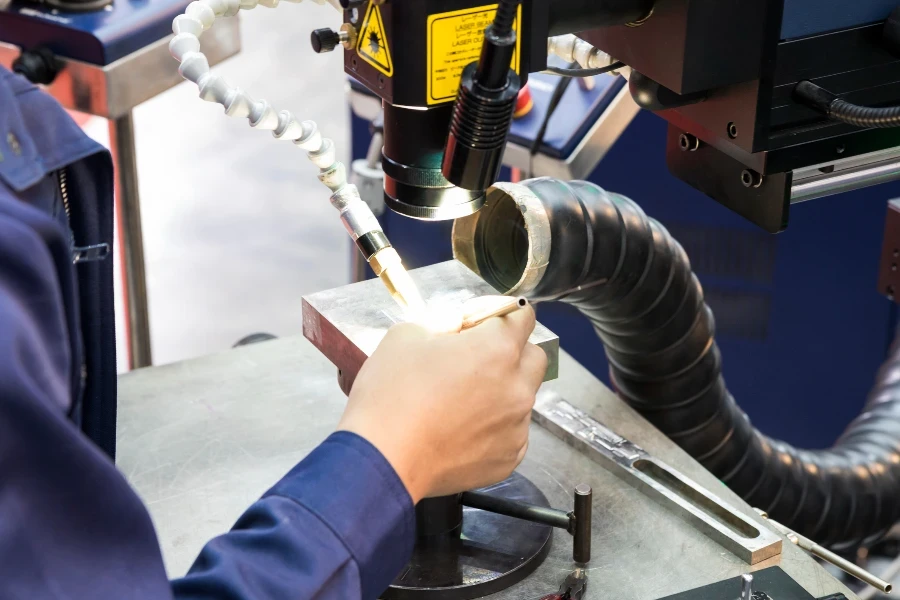
Die Einhaltung gesetzlicher Normen und Zertifizierungen ist für die Sicherheit und Zuverlässigkeit tragbarer Laserschweißgeräte von entscheidender Bedeutung. Hersteller müssen verschiedene internationale Normen einhalten, um die strengen Anforderungen verschiedener Branchen zu erfüllen.
ISO- und ANSI-Standards
Handgeführte Laserschweißgeräte müssen ISO-Normen wie ISO 17526 erfüllen, die sich auf die Lebensdauer von Lasern und laserbezogenen Geräten beziehen. Diese Norm stellt sicher, dass die Laserschweißgeräte langlebig gebaut sind und während ihrer gesamten Betriebslebensdauer zuverlässig funktionieren.
Darüber hinaus ist die Einhaltung von ANSI Z136.1, der Norm für den sicheren Einsatz von Lasern, für die Sicherheit des Bedieners von entscheidender Bedeutung. Diese Norm beschreibt die erforderlichen Sicherheitsmaßnahmen, darunter Schutzbrillen, Warnschilder und Sicherheitsverriegelungen, um Unfälle und Verletzungen zu verhindern.
CE- und UL-Zertifizierungen
CE- und UL-Zertifizierungen sind unerlässlich, um sicherzustellen, dass tragbare Laserschweißgeräte die auf dem europäischen bzw. nordamerikanischen Markt erforderlichen Sicherheits- und Leistungsstandards erfüllen. Diese Zertifizierungen belegen, dass die Geräte strengen Tests unterzogen wurden und die erforderlichen Sicherheits- und Qualitätsstandards erfüllen.
So stellt beispielsweise die CE-Zertifizierung sicher, dass das Schweißgerät die Gesundheits-, Sicherheits- und Umweltschutzanforderungen der Europäischen Union erfüllt. Ebenso bedeutet die UL-Zertifizierung, dass die Ausrüstung die Sicherheitsstandards von Underwriters Laboratories erfüllt, einer weltweit anerkannten Sicherheitszertifizierungsorganisation.
Ersteinrichtung und Wartung
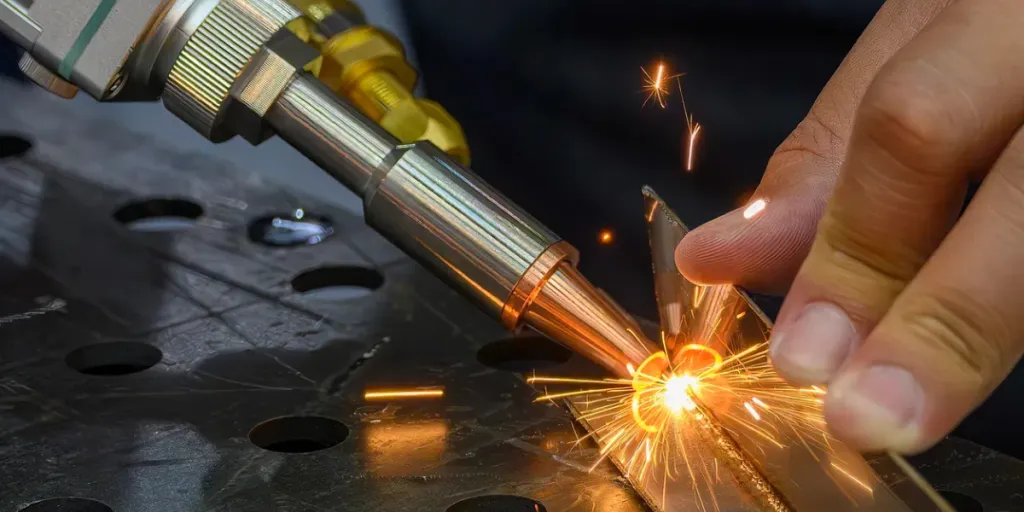
Die Ersteinrichtung und die laufende Wartung von tragbaren Laserschweißgeräten sind entscheidende Faktoren, die sich auf ihre Leistung und Langlebigkeit auswirken. Eine ordnungsgemäße Installation und regelmäßige Wartung stellen sicher, dass das Gerät effizient und zuverlässig arbeitet.
Ersteinrichtung
Die Ersteinrichtung eines tragbaren Laserschweißgeräts umfasst mehrere Schritte, darunter die Montage der Komponenten, die Kalibrierung des Lasers und die Konfiguration der Schweißparameter. Um eine ordnungsgemäße Installation zu gewährleisten, müssen unbedingt die Anweisungen und Richtlinien des Herstellers befolgt werden.
Einige Schweißgeräte verfügen über benutzerfreundliche Einrichtungsassistenten und automatische Kalibrierungsfunktionen, die den Installationsprozess vereinfachen. Diese Tools führen den Bediener durch die Einrichtungsschritte und stellen sicher, dass das Gerät für eine optimale Leistung richtig konfiguriert ist.
Regelmäßige Wartung
Um tragbare Laserschweißgeräte in Topzustand zu halten, ist regelmäßige Wartung unerlässlich. Dazu gehört das Reinigen der Laseroptik, das Überprüfen des Kühlsystems und der elektrischen Anschlüsse. Hersteller stellen in der Regel Wartungspläne und -richtlinien zur Verfügung, die den Bedienern bei der Durchführung routinemäßiger Wartungsaufgaben helfen.
Darüber hinaus sind einige Schweißgeräte mit Diagnosetools ausgestattet, die den Zustand der Ausrüstung überwachen und den Bediener auf mögliche Probleme aufmerksam machen. Diese Tools helfen, unerwartete Ausfallzeiten zu vermeiden und die Lebensdauer der Ausrüstung zu verlängern, indem sie Wartungsbedarf umgehend berücksichtigen.
Zusammenfassend
Handgeführte Laserschweißgeräte sind vielseitige und leistungsstarke Werkzeuge, die zahlreiche Vorteile für verschiedene Schweißanwendungen bieten. Bei der Auswahl eines handgeführten Laserschweißgeräts müssen Faktoren wie Lasertyp, Leistungsabgabe, Benutzerfreundlichkeit, Sicherheitsstandards und Kompatibilität mit anderen Geräten berücksichtigt werden. Fortschritte in der Technologie, Einhaltung gesetzlicher Vorschriften und ordnungsgemäße Wartung verbessern die Leistung und Zuverlässigkeit dieser Schweißgeräte weiter. Durch sorgfältige Bewertung dieser Faktoren können Unternehmen das am besten geeignete handgeführte Laserschweißgerät auswählen, das ihren spezifischen Anforderungen entspricht und qualitativ hochwertige Schweißergebnisse erzielt.
